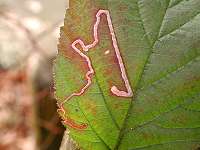Stigmella aurella
The family Nepticulidae consists of some 70 species in Britain. Most of them belong to just one genus: Stigmella. Most Stigmella are brown micro moths. The wings usually have a white band running over it, or one or more white spots. The wingspan varies from 4 to 10 mm, meaning that when resting on a leaf they measure about 2 to 5 mm in length. So it is very hard indeed to discover them at all. Yet we do know quite a lot about them. That's due to the larvae of most species mining leaves. This means they are small enough to live within a leaf. The animals crawl forward eating the inside of the leaf. By doing so they leave behind a trail, which can be seen from the outside easily. These trails are called mines. By studying the mines we are often able to tell which species produced it, for each species leaves behind a characteristic mine. It is essential though to know the species of plant the leaf has been taken from. In this way we don't have to find the animals themselves, which would be a tedious task, to know they are there. This method of studying the circumstancial evidence rather then the animal itself is not uncommon in biology. Galle apples, caused by tiny wasps or flies, are a good exemple of this. Prints of paws in sand or snow give away many nocturnal mammals. And so does examining the contents of the balls spitted out by owls containing hairs and bones of mice and other small creatures they feed on. In the picture you see the leaf of a bramble and in it the clear mine of one of the Stigmella species. Most probably this one has been made by Stigmella aurella, a tiny moth having a wingspan of no more than 5 mm. However the mines left by Stigmella splendidissimella (just try to pronounce that quickly!) in bramble leaves are almost identical, so it could be this species.
The family Nepticulidae consists of some 70 species in Britain. Most of them belong to just one genus: Stigmella. Most Stigmella are brown micro moths. The wings usually have a white band running over it, or one or more white spots. The wingspan varies from 4 to 10 mm, meaning that when resting on a leaf they measure about 2 to 5 mm in length. So it is very hard indeed to discover them at all. Yet we do know quite a lot about them. That's due to the larvae of most species mining leaves. This means they are small enough to live within a leaf. The animals crawl forward eating the inside of the leaf. By doing so they leave behind a trail, which can be seen from the outside easily. These trails are called mines. By studying the mines we are often able to tell which species produced it, for each species leaves behind a characteristic mine. It is essential though to know the species of plant the leaf has been taken from. In this way we don't have to find the animals themselves, which would be a tedious task, to know they are there. This method of studying the circumstancial evidence rather then the animal itself is not uncommon in biology. Galle apples, caused by tiny wasps or flies, are a good exemple of this. Prints of paws in sand or snow give away many nocturnal mammals. And so does examining the contents of the balls spitted out by owls containing hairs and bones of mice and other small creatures they feed on. In the picture you see the leaf of a bramble and in it the clear mine of one of the Stigmella species. Most probably this one has been made by Stigmella aurella, a tiny moth having a wingspan of no more than 5 mm. However the mines left by Stigmella splendidissimella (just try to pronounce that quickly!) in bramble leaves are almost identical, so it could be this species.




